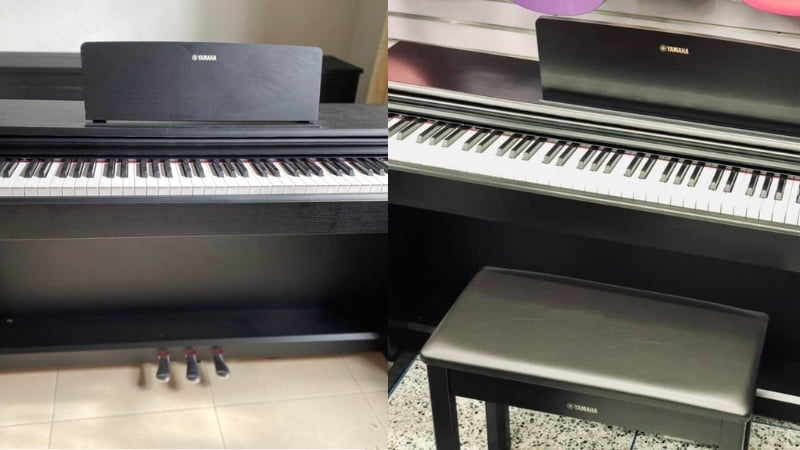Learn all the differences between these pianos and which one is the better option in this Yamaha YDP144 vs YDP-144R review.
If you’ve been looking for a digital console piano, there’s a high chance you’ve seen the Yamaha YDP-144. This is one of the best mid-range options Yamaha has to offer that isn’t too expensive but also offers great features.
But have you heard of the Yamaha YDP-144R?
This is another version of the YDP-144 that offers many of the same features but offers a different finish. Instead of the classic black finish, the YDP-144R has a deep brown rosewood finish. This doesn’t affect the sound that much, but it does offer a different aesthetic.
So, which piano is better?
At the end of the day, these two pianos sound and feel the same. That’s why when finding the best fit for your needs, I recommend giving the two pianos a good look and deciding which one fits your aesthetics better.
If you’re curious about the other differences between these pianos and what makes them great options, you’ve come to the right place. I’ll dive into all of these details and more in this Yamaha YDP-144 vs YDP-144R review.
Yamaha YDP-144 vs YDP-144R: Comparison Chart

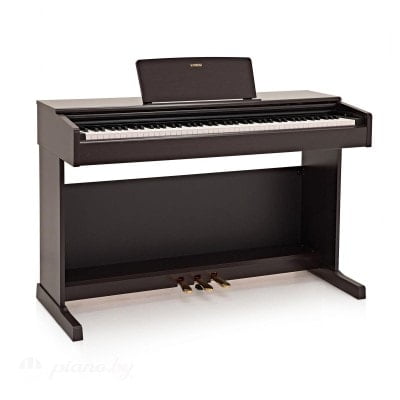


Last update on 2025-07-03 / Affiliate links / Images from Amazon Product Advertising API
Yamaha YDP-144 vs YDP-144R: What’s the Difference?
There aren’t that many differences between these two pianos. In fact, after all my research, I found that the only difference is the way these pianos look. With the YDP-144, you get a classic ebony-toned finish. This is a very classic look that reminds me of classic acoustic pianos.
This is a fairly simple design, and it works for most rooms. I really enjoyed the subtle grains on the piano that add a lot of character. If you’re looking for a classy-looking digital piano for your home or performance venue, this is a great pick.
On the flip side, the YDP-144R has a rosewood finish. This is a lighter wood, so the piano has a dark brown shade. This is a really cool look and is a great pick if you want an older aesthetic with your piano. Just like the YDP-144, this piano has a subtle grain on the wood to make it look even classier.
Aside from the piano’s finish, these models are exactly the same. So, I couldn’t exactly choose a winner. When all is said and done, you’re going to have to go back to your personal preference and decide which color is best-suited to your tastes.
That said, I want to mention that the Yamaha YDP-144 is easier to find than the YDP-144R. For some reason, there were more YDP-144 models available on the internet than the YDP-144R. So, if you’re looking for a piano and need it fast, the YDP-144 might be the better option.
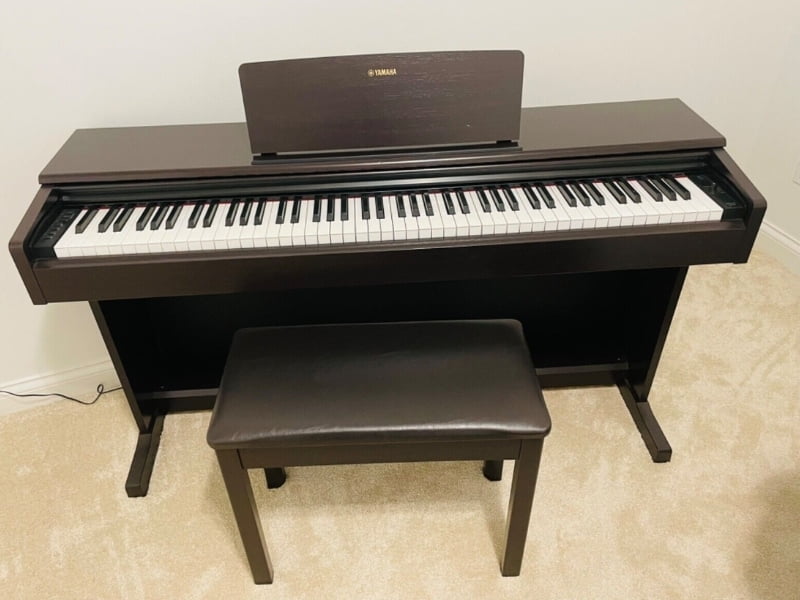
YDP-144 and YDP-144R: The Similarities
So, what are these pianos like underneath their individual finishes?
Well, they’re exactly the same. When you look at the tone engine, hammer action, and even the voices available on these pianos, you won’t find any differences. These are both great console digital pianos for the price.
And in this section, we’re diving into some of their key features and why they are great picks for many pianists.
Tone
To start, both of these pianos have a great piano tone. Since they are console digital pianos, they aren’t built for versatility. Instead, these pianos are built to mimic the sound and feel of an acoustic piano. So, while you don’t get the most varied sound library, rest assured that you get top-quality tones.
+Tone Generation
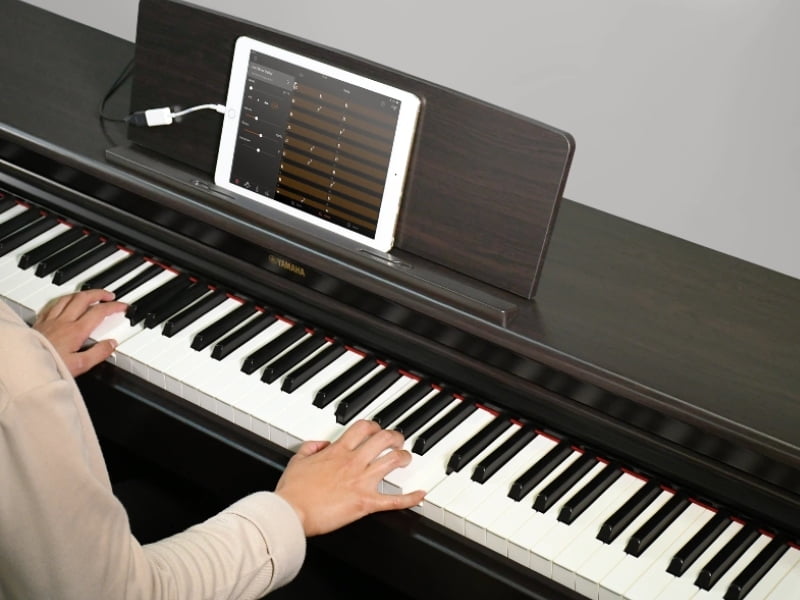
The reason these pianos offer realistic piano tones is the Yamaha CFX tone engine. This is a great tone generator that relies on samples recorded from the Yamaha CF Grand Piano. Aside from using the best recording equipment available to get these samples, Yamaha also used different recording techniques.
That way, you get a bright piano sound, a dark piano sound, and a classic grand piano sound for different pieces. And rest assured that whichever piano sound you choose, you’ll get a realistic and detailed tone.
This is a key reason why the Yamaha CFX tone engine is well-respected in the music industry. While it isn’t the best tone engine Yamaha has to offer, it’s relatively affordable while offering the most realistic tones in its price range.
So, if you want a digital piano that sounds like a real acoustic piano, the YDP-144 and YDP-144R are both great picks.
+Sound Library
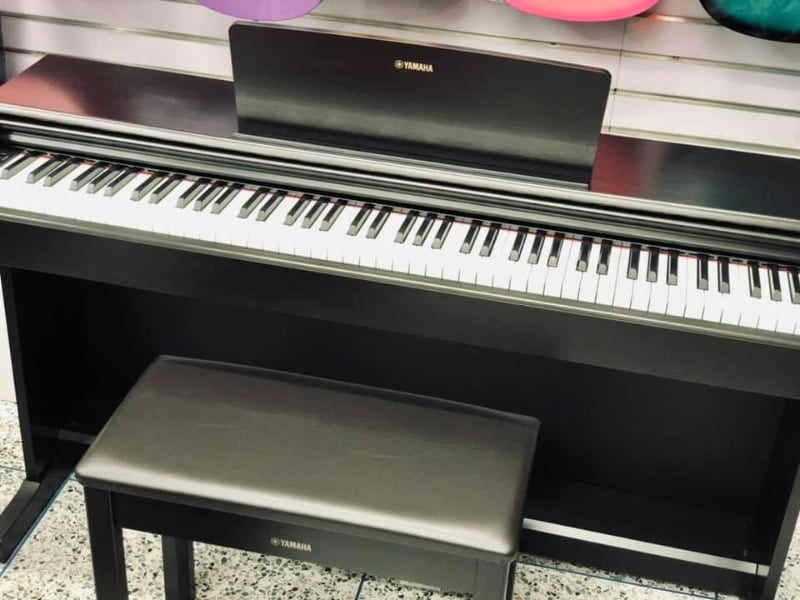
One of the downsides when you get either the YDP-144 or the YDP-144R, is that they have fairly limited sound libraries. As mentioned earlier, these pianos are designed to replicate the sound of real instruments, not to offer a vast selection of voices.
So, you only get 10 voices with either of these pianos. That said, the sound library includes a few piano tones, an electric piano tone, harpsichord, organ, and strings voices. And as a pianist, these are all the voices you’re going to need to play various musical styles.
And if you’re a beginner or novice pianist, you won’t need a wide sound library anyway. When you’re learning how to play an instrument, it’s best to stick to the essential tones and features, so you don’t get distracted.
This is why I feel like the YDP-144 and YDP-144R are some of the best beginner and novice digital pianos available today.
Feel
The next feature I’ll talk about is the feel. These pianos offer a fairly realistic piano feel, especially for the price. And while I had some issues with the key texture, I was still pretty satisfied with what the YDP-14 and YDP-144R had to offer.
+Hammer Action
Both of these pianos use the Graded Hammer Standard. This is also called GHS, and it’s one of Yamaha’s best hammer actions. This isn’t the most premium Yamaha hammer action, but it’s a great middle ground between fully-weighted keys and the premium hammer action you’ll find on stage pianos.
The reason GHS is different from a fully-weighted hammer action is that it doesn’t have a uniform weight. When you play an acoustic piano, you’ll notice that all the keys have a slightly different weights. The bass keys are typically heavier than the bass keys, and the GHS action captures these subtle differences.
This is why the YDP-144 and YDP-144R both feel like real acoustic pianos.
That said, I had one complaint with the feel of these pianos and that’s the key texture. The Yamaha YDP-144 and YDP-144R only feature coated black keys and regular glossy white keys.This is why the black keys have a matte texture and the white keys are fairly slippery.
It would have been nice if Yamaha added a different coating on the white keys as well. That way, the pianos would feel even more realistic and offer more value for the money.
But considering the fact that these are mid-range digital pianos, it’s easy to understand why Yamaha chose to only coat the black keys.
Polyphony
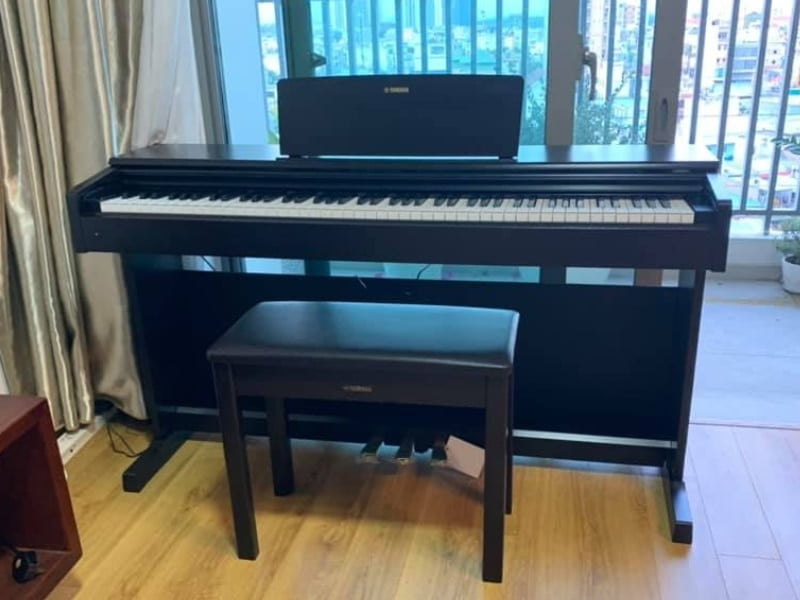
The last important feature I want to talk about today is polyphony. Polyphony is the maximum number of notes a digital piano can play simultaneously. And ideally, you want to get a digital piano that has a high polyphony so that you can play any piano piece and add more emotion and expression to your playing.
Luckily, these pianos come with 192-note polyphony. And at this price point, you can’t ask for much better. With 192-note polyphony, you can play as many notes as you want simultaneously. While no piano piece will require you to play a 192-note chord, there are some pieces that require you to hold the sustain pedal and constantly stack notes on top of each other.
With 192-note polyphony, rest assured that the notes will ring out for much longer and capture all the expressions you want to add to the music.
All in all, these pianos offer a lot of value for the money and are great options for beginner and novice pianists. The only difference between these two instruments is the color, so all you have to do is decide which finish is the best fit for your home!
Quick Rundown of the Yamaha YDP-144
- Your purchase includes One Yamaha Arius Series, YDP144 model | Bench, 50 Classical Music Masterpieces Book, Owner’s manual & Quick Operation Guide
- Piano dimensions – 53-7/16” W x 32-1/16” H x 16-5/8” | Weight – 83 lbs. | Number of pedals – 3 | Max polyphony – 192 | Number of voices – 10 | Headphones – (2) Standard Stereo phone jack | With Recording and Playback capabilities
- GHS weighted action is heavier in the low keys and lighter in the high keys, just like an acoustic piano
- Half-damper pedal control allows for continuously increasing amounts of sustain as the pedal is depressed
- The CFX Premium Grand Piano Voice recreates the power and tone of the flagship CFX concert grand piano from Yamaha
Last update on 2025-07-03 / Affiliate links / Images from Amazon Product Advertising API
Quick Rundown of the Yamaha YDP-144R
Related Articles to Yamaha Ydp 144
- Yamaha YDP-144 vs YDP-S54: What’s the Difference?
- Yamaha YDP-144 vs 184: Which Is the Best Arius Model for the Money?
- Yamaha YDP-144 vs YDP-181: Is the YDP-144 a Worthy Upgrade?
- Yamaha YDP-144 vs Roland F-140R: Which Digital Piano Do You Need?
- Yamaha YDP-144 vs Kawai KDP-120: Which Piano Is the Best?
- Yamaha YDP-144 vs Kawai KDP-110: Why the YDP-144 Is the Better Piano
- Yamaha YDP-144 vs 164: Which Is the Better Arius Piano?
- Yamaha DGX-660 vs YDP-144: Which Is the Better Yamaha Piano?
- Yamaha DGX-670 vs YDP 144: Finding the Best Digital Piano
- Yamaha YDP144 vs 163: Which Is The Best Arius?
- Yamaha YDP144 vs S34: Which Suits Your Style Better?
- Yamaha YDP-143 Vs 144: Is The YDP-144 A Worthy Upgrade?
- Yamaha YDP-103 Vs 144: A Battle Of Two Arius Models
- Casio PX-870 Vs Yamaha YDP-144: Which Is The Better Console Digital Piano?
- Casio PX-770 vs Yamaha YDP-144: Which Is The Better Digital Piano?
References:
- Yamaha YDP-144: https://usa.yamaha.com/products/musical_instruments/pianos/arius/ydp-144/specs.html#product-tabs
- Yamaha YDP-144R: https://www.sweetwater.com/store/detail/YDP144RW–yamaha-arius-ydp-144r-digital-home-piano-with-bench-rosewood
Lulacruza is an electronic folk duo operating at the junction of the hypermodern and the ancient. Our music weaves together hypnotic female singing, South American folk instruments and electronic processing, while channeling pulsating waves from the source of creation.
Lalucruza is also a community where you can connect with other music lovers to collaborate, exchange ideas and share knowledge. A platform for who wants to learns the basics of playing piano, guitar, drum masters’ technique, etc.. is the premise of our website.
